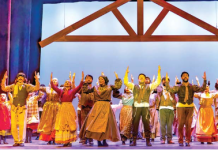By Linda McK.Stewart
Stone is stern. Its heft, its texture, its impermeability all affirm that fact. Stone is nature in a serious mood. Stone is not to be taken lightly. And who would know that better than world-renowned, 66-year old sculptor, Andy Goldsworthy. Yet who can view his serpentine stone wall at the Storm King Art Center in Mountainville, N.Y. without a smile?
Behold that wall, built in 1999, nearly half a mile long, compiled (so say the statisticians) of 1,579 tons of local stone. At its highest it stands about 5 feet and elsewhere sinks to hardly a foot, one stone artfully placed upon another, mortar-free. It meanders through meadow and woodlands. It winds absurdly around maples and oaks in a series of joyous arabesques before plunging down into a pond to emerge triumphantly on the far side and shooting straight uphill before coming to an abrupt stop just short of a busy highway. Stone, stern stone, by the magic of the artist’s hand, here conveys merriment, frivolity, even buoyancy. Such is the genius of an artist like Goldsworthy whose work at the 500-acre sculpture park keeps company with 100 other pieces courtesy of his artistic peers including Alexander Calder, Roy Lichtenstein, Isama Noguchi, Maya Lin, Louise Nevelson, Henry Moore and Richard Serra. And that’s just for openers.

Andy Goldsworthy, born in Cheshire, England, grew up in Yorkshire but calls tiny Penpont, Scotland home. On his way to becoming one of the most acclaimed contemporary artists, he tried his hand as a sheepherder, gardener and farmer and managed as well a stint or two in respectable art schools. But the classroom was never his cup of tea. It’s the outdoors, in fair weather or foul, in torrid climes or arctic snows that stir his creative juices. Today Goldsworthy’s work can be found in such far-flung places as Japan, the Northern Territories of Canada, the Australian Outback, the Yorkshire Dales, the North Pole, as well as in St. Louis, Mo. and the Museum of Jewish Heritage in lower Manhattan.
A few summers ago the Metropolitan Museum commissioned him to do a rooftop exhibit of stone and tree branches. To the dismay of some museum visitors thunderstorms with drenching rains and blustery winds played havoc with his rooftop creation. But the artist himself was delighted. To see his handiwork set upon by the elements was exactly what he anticipated, what he wished for. Rather like a modern-day Thoreau, Andy Goldsworthy could aptly be called a high priest of nature. He says as much himself: “We often forget that we are nature. Nature is not something separate from us. So when we say that we have lost our connection to nature, we’ve lost our connection to ourselves.”
To the dismay of many, he has no wish to prevent decay, whether by rust, wind, tide, drought or time. His wall at Storm King will gradually succumb to erosion, tree roots or maybe wildlife, which is just as it should be. His only concession towards preservation is by photography. Art books of his far-flung creations capture his ice sculpture on a Nova Scotian beach, a golden raft of dandelion blooms sweeping down a Highland river or a cairn of stones stacked within easy reach of the next high tide. Books of Andy Goldsworthy’s work are as handsome as they are expensive.
Storm King Art Center covers a diverse landscape of rolling hills, woodlands and open spaces, ideal for the massive works of art that cry out for space, for air and sky. Visitors are free to walk around each piece, to give a good knuckle rap to its wood or steel or marble surface. There’s no “Do Not Touch” at Storm King. Families delightedly cluster around the Three Legged Buddha for prized photo ops. Kids stretch out beside Thomas Houseago’s Sleeping Boy and stroke the bronze feathers of his Standing Owl. Cyclists have access to miles of bike paths and for bike-less visitors there are rental bikes. For less athletic bipeds, trams depart the parking area at 20-minute intervals, each with a narrating guide. Visitors can get on and off as they please. Weekend programs designed especially for children are scheduled from May well into October. Afternoon and evening concerts invite visitors to bring picnics. For non-picnickers there is a pleasant but modest café with immodest prices. No worry about securing a seat for the concert. There is room for all … right there on the grass.
The idea that evolved into the present-day sculpture park was conceived 50 years ago by Ralph Ogden, a local resident, philanthropist and lifelong lover of art. From the first, it was stipulated that the collection would be confined to works created between World War II and the present. It was Ralph Ogden’s own collection of 13 massive sculptures of welded steel by the late iconic sculptor David Smith that formed the nucleus of the Storm King collection.
For a midsummer, daylong outing, it would be hard to find a venue more appealing than the Storm King Art Center, scarcely an hour, door to door.
IF YOU GO: The Storm King Art Center is open 10 a.m. to 5:30 p.m. Wednesday through Sunday. For driving directions and details of coming events call 845-534-3115.














